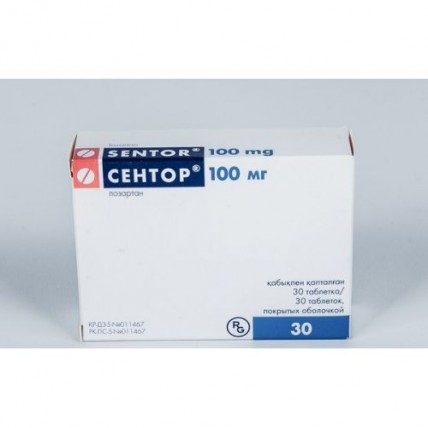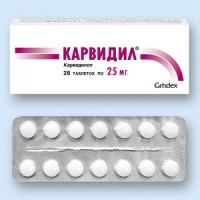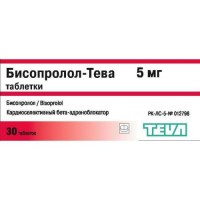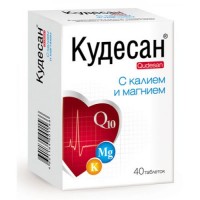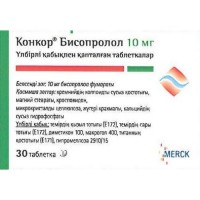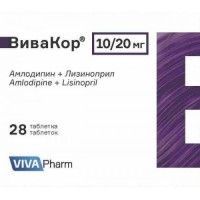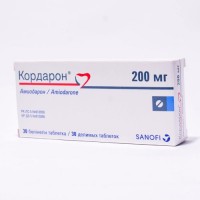Sentor® 30s 100 mg coated tablets
- $17.80
Sku:
745f6fb6f8eb
Ingredient:
Losartan
The instruction for medical use
of CEHTOP® SENTOR® medicine
A trade name
of Sentor®
of Sentor®
the International unlicensed
name Lozartan Lekarstvennaya
the Tablet form, coated, 50 mg, 100 mg
Structure
One tablet contains
active agent - lozartan potassium of 50 mg and 100 mg
excipients: a kernel - silicon dioxide colloidal, magnesium stearate, sodium of a kroskarmelloz, starch prezhelatinizirovanny, cellulose microcrystalline, a cover - OPADRI II, 33G28523 white (a glitserola triacetate, a macrogoal, lactoses monohydrate, the titan dioxide, E171, S. I. 77891,
gipromelloza).
The description
of the Tablet of 50 mg
of the Tablet, coated, round biconvex, white or almost white color, on one party – risk, on another – an engraving 50.
Tablets of 100 mg
of the Tablet, coated, oval biconvex, white or almost white color, on one party - an engraving 100, other party – smooth.
Pharmacotherapeutic group
the Drugs influencing renin-angiotenzinovuyu a system.
Antagonists of angiotensin II
Code of automatic telephone exchange C09C A01
Pharmacological
Pharmacokinetics Absorption properties. After oral introduction lozartan it is well soaked up, and at the same time there takes place primary metabolism at which one active carboxyl metabolite is formed. Biological availability of a lozartan about 33%. The maximum concentration of a lozartan and its active metabolite is noted respectively approximately in an hour and in 3-4 hours after reception. Meal does not affect bioavailability of a lozartan.
Distribution. ≥99% of a lozartan and its active metabolite contact proteins of blood plasma, generally albumine. Volume of distribution of a lozartan of potassium of 34 l.
Biotransformation. About 14% of the entered dose turn into an active metabolite. Metabolism of a lozartan can be reduced approximately at 1% of people, as a result concentration of an active metabolite in blood plasma will be less.
Except pharmacological active metabolite, a number of inactive metabolites of which more important it is formed by hydroxylation of a butyl side chain is formed, and less important it is a N-2-tetrazole-glucuronide.
Elimination. The clearance of a lozartan is 600 ml a minute, and an active metabolite of 50 ml a minute. The renal clearance of a lozartan and its active metabolite is 74 ml and 26 ml a minute, respectively. At oral introduction of a lozartan, about 4% of the entered dose also 6% in the form of an active metabolite are allocated with urine in an invariable look.
The linear pharmacokinetics of a lozartan and its active metabolite is noted at intake to 200 mg.
After oral introduction of a lozartan, concentration of a lozartan and its active metabolite decreases poliexponentsialno. Terminal elimination half-life of a lozartan about 2 hours, and active metabolite about 6-9 hours. At a dose in 100 mg in day of cumulation of a lozartan and its active metabolite in blood plasma it is not noted.
Lozartan and his metabolites are allocated from an organism through bile (58%) and through an urinary system (35%).
Pharmacokinetic indicators at special groups of patients.
Patients with cirrhosis of easy and average degree have a concentration of a lozartan and its active metabolite in blood plasma increases in 5 and 1.7 times, respectively.
At patients with a renal failure with clearance of creatinine> 10 ml min. concentration of a lozartan and its active metabolite in blood plasma does not change. At the patients needing a hemodialysis, concentration of a lozartan in blood plasma increases twice, in comparison with persons with normal renal function.
Lozartan and his active metabolite do not leave from an organism by a hemodialysis.
Pharmacokinetic properties at children.
Studying pharmacokinetics of a single oral dose of 0.54-0.77 mg kg on 50 children (aged from 1 month up to 16 years) showed similar pharmacokinetics that at adults.
The pharmacodynamics
Lozartan – active agent of the drug Sentor, concerns antagonists of angiotensin II. Lozartan, blocking AT1-receptors of angiotensin II causes vasodilation and decrease in level of Aldosteronum therefore arterial blood pressure decreases. Blockade of AT1-receptors of angiotensin II lozartany increases the level of renin and angiotensin II in blood plasma. However, as a result of high affinity of a lozartan to angiotensin II AT1-receptors, its antihypertensive effect remains.
Lozartan selectively blocks AT1-receptors and does not block other hormonal receptors or ion channels which are important in terms of regulation of a cardiovascular system. Besides, lozartan does not block APF (kininaza of II) which splits bradykinin. Therefore lozartan does not cause such effects which are not connected directly with blockade of a receptor of AT1.
It is established what lozartan blocks reactions, stimulated angiotensin I and angiotensin II, and does not influence bradykinin reactions.
At patients with a hypertension without presence of diabetes who have a proteinuria the use of a lozartan of potassium considerably reduces a proteinuria. Lozartan supports the speed of glomerular filtration and reduces filtrational fraction. Lozartan reduces urea level in blood plasma (on average in
Lozartan does not influence autonomous reflexes and noradrenaline level in blood plasma.
Lozartan in a dose up to 150 mg a day does not influence the level of triglycerides, cholesterol and LVP-cholesterol in blood serum at patients with a hypertension
and also on glucose level in blood on an empty stomach.
After administration of drug the maximum antihypertensive effect is noted in 5-6 hours and remains till 24 o'clock. Despite considerable decrease in the ABP, lozartan did not influence considerably heart rate. Drug is to the same extent effective at women and men, at relatively young (
Indications
- arterial hypertension, including in non-insulin-dependent diabetes mellitus with a proteinuria
the Route of administration and doses
Sentor is accepted 1 time a day at the same time, it is long.
Considering that food does not influence absorption of active ingredient, the drug can be taken irrespective of meal.
The drug Sentor can be combined freely with other antihypertensive drugs.
Arterial hypertension
the Recommended initial and maintenance dose of 50 mg of times a day. The stable lowering of arterial pressure develops after 3-6 weeks administration of drug. For increase in efficiency of drug it is possible to increase a dose to 100 mg a day.
At decrease in volume of the circulating blood the recommended initial dose makes 25 mg a day.
Reduction of risk of a stroke at patients with a hypertension and a hypertrophy of a left ventricle
the Recommended initial dose of drug: 50 mg of times a day. Depending on arterial blood pressure, it is reasonable to apply in addition low doses of Hydrochlorthiazidum and/or to raise a single daily dose of the drug Sentor to 100 mg.
Arterial hypertension at patients with non-insulin-dependent diabetes mellitus with a proteinuria
the Recommended initial dose of drug: 50 mg of times a day. Depending on the level of arterial blood pressure, it is possible to raise a single daily dose of drug to 100 mg.
The renal failure
Is not present need for definition of an individual dose of drug in the presence of a renal failure of easy degree (clearance of creatinine within 20-50 mg/ml). In a renal failure, average or heavy degree (clearance of creatinine
the Liver failure
it is reasonable to This patient to apply lower dose of drug.
Advanced age
When assigning is not required to persons up to 75 years of dose adjustment. In case of use of drug among persons 75 years, because of insufficient experience are more senior, the initial dose of drug of 25 mg a day is recommended.
Experience of use for children and teenagers
Limited results of pharmacokinetic researches at children with hypertensia is aged more senior than 1 month.
On the basis of the available data the recommended dose for children and teenagers with the body weight of 25-50 kg makes 25 mg a day. If necessary the daily dose can be increased up to 50 mg. For patients with body weight it is more than 50 kg, the initial dose makes 50 mg of times a day which if necessary can be increased up to 100 mg.
Side effects
Side effects of a lozartan usually poorly expressed and passing which do not demand interruption of a course of therapy. All side effects noted at use Sentor, considering the frequency of their manifestation, were identical with a profile of the side effects noted at placebo use.
At use Sentor for treatment of an essential hypertension in the controlled researches, only the frequency of dizzinesses differed from placebo more than for 1% (4.1% against 2.4%).
The dose-dependent orthostatic action characteristic of antihypertensive drugs, at use Sentor was noted less than at 1% of patients.
In the double blind controlled clinical trials with participation of patients with an essential hypertension the following side effects were observed at the patients receiving Sentor (irrespective of whether there is a communication of side effects using drug).
Frequency of side effects:
- very frequent (> 1/10): a headache
- frequent (> 1/100 - dizziness, insomnia, heartbeat,
tachycardia, congestion of a nose, pharyngitis, inflammation of adnexal bosoms of a nose,
an upper respiratory tract infection, an abdominal pain, a diarrhea, the dispepsichesky phenomena, nausea,
a dorsodynia, muscular spasms, thorax pain, asthenia/exhaustion,
a hyperpotassemia, increase in levels of aspartate aminotransferase and alaninaminotranspherase (ASAT, ALAT)
- infrequent (> 1/1000 - an eosinophilia, vertigo, sonitus, orthostatic hypotension, nasal bleeding, a constipation, skin rashes, a general malaise, increase in level of urea and residual nitrogen or creatinine in blood serum.
- rare (> 1/10,000 - anemia, thrombocytopenia, migraine, a vasculitis,
Shenleyn's purpura – Genokh, cough, urticaria, an itching, myalgias, arthralgias, anaphylactic reactions, a Quincke's disease, hepatitis, disturbance of functional indicators of a liver.
In the controlled clinical trials which are carried out with participation of patients with diabetes 2 types with a nephropathy, the tolerance of patients to a lozartan was good. The most often met side effects were the following:
- asthenia/exhaustion
- dizziness
- hypotonia
- a hyperpotassemia (at 9.9% of the patients receiving lozartan and at 3.4% of the patients receiving placebo), at some patients interrupted a therapy course lozartany because of a hyperpotassemia. During treatment lozartany potassium level in blood serum should be controlled, especially at elderly patients.
Since drug entry into the market there are also messages about the following side effects:
- anaphylactic reactions, Quincke's diseases, in particular hypostasis of a throat, language
Seldom:
- Shenleyna-Genokh's purpura, a vasculitis
- myalgias, an arthralgia
- diarrhea
- hepatitis, abnormal liver functions
- anemia, thrombocytopenia
- migraine
- cough
- urticaria, an itching, skin rashes
of the Contraindication
- hypersensitivity to active ingredient or to any of drug excipients
- children with body weight is less than 25 kg
- children with body weight higher than 25 kg, with glomerular filtration below, than 30 ml/min. / 1.73 of m ² and with abnormal liver functions (due to the lack of experience)
- pregnancy and a lactation
- a hyperpotassemia
Medicinal interactions
With Hydrochlorthiazidum, digoxin, warfarin, Cimetidinum, phenobarbital, ketokonazoly and erythromycin did not note clinically considerable pharmacokinetic interaction. According to messages rifampicin and flukonazol reduce the level of an active metabolite of a lozartan in blood plasma. The clinical value of these interactions is still unknown.
At joint prescribing of the drug Sentor:
- with kaliysberegayushchy diuretics (e.g.: Spironolactonum, Triamterenum, amiloride), the drugs K+ can lead to increase in level of potassium in blood plasma
- with non-steroidal anti-inflammatory drugs (NPVS, acetylsalicylic acid in a dose is higher than 3 g in day), including specific inhibitors of cyclooxygenase-2 (TsOG-2), can reduce efficiency of antagonists of a receptor of angiotensin II
- with drugs NPVS, especially in the presence of the lowered function of kidneys, can lead to a renal failure, including an acute renal failure and increase in level of potassium in blood plasma. This effect is usually reversible. At combined use of these drugs, especially at older persons at whom at introduction of necessary amount of liquid it is necessary to control a functional condition of kidneys at the beginning and during therapy
- with lithium salts, reversible increase in concentration of lithium in blood plasma and its toxicity was noted. If it is necessary to use drugs in common, it is regularly necessary to control lithium level in blood plasma.
The drug Sentor can be used in common with other antihypertensive drugs (with diuretics, with blockers of calcium channels, with alpha, beta adrenoblockers or with drugs of the central action) and also with insulin and with other means applied to treatment of diabetes (with sulphonylurea derivatives, from glitazona and with alpha glucosidase inhibitors).
Combined use of the drug Sentor with diuretics derivative the tiazida causes the effect close to additive.
Special instructions
it is not recommended to transfer patients from APF inhibitor on Sentor.
During treatment lozartany potassium level in serum should be controlled, especially at elderly patients.
There Is no feature of influence of medicine on ability to run the vehicle or potentially dangerous mechanisms data that Sentor would affect ability of driving of the car and for work with mechanisms with the increased risk of traumatism, but considering side effects of drug it is necessary to be careful.
The overdose
Is available few data on drug overdose. The most possible symptoms of overdose: hypotonia, changes of a heart rhythm.
Symptomatic treatment.
A form of release and packing
of the Tablet, coated, 50 mg and 100 mg
of 10 tablets in the blister from PVH/PE/PVDH-plyonki and aluminum foil. 1 or 3 blisters in a cardboard box with the enclosed instruction for use.
To Store storage conditions at a temperature from +15 °C to +25 °C
to Store out of children's reach!
Period of storage
Sentor of a tablet, coated, 50 mg: 5 years
Sentor of a tablet, coated, 100 mg: 3 years
not to use after expiry date!
Prescription status
According to the prescription
The producer
the Grodzisky pharmaceutical plant Polfa of the lake of the lake of the lake, Poland
for JSC Gideon Richter, Budapest, Hungary
to Develop
of CEHTOP® SENTOR® medicine
A trade name
of Sentor®
of Sentor®
the International unlicensed
name Lozartan Lekarstvennaya
the Tablet form, coated, 50 mg, 100 mg
Structure
One tablet contains
active agent - lozartan potassium of 50 mg and 100 mg
excipients: a kernel - silicon dioxide colloidal, magnesium stearate, sodium of a kroskarmelloz, starch prezhelatinizirovanny, cellulose microcrystalline, a cover - OPADRI II, 33G28523 white (a glitserola triacetate, a macrogoal, lactoses monohydrate, the titan dioxide, E171, S. I. 77891,
gipromelloza).
The description
of the Tablet of 50 mg
of the Tablet, coated, round biconvex, white or almost white color, on one party – risk, on another – an engraving 50.
Tablets of 100 mg
of the Tablet, coated, oval biconvex, white or almost white color, on one party - an engraving 100, other party – smooth.
Pharmacotherapeutic group
the Drugs influencing renin-angiotenzinovuyu a system.
Antagonists of angiotensin II
Code of automatic telephone exchange C09C A01
Pharmacological
Pharmacokinetics Absorption properties. After oral introduction lozartan it is well soaked up, and at the same time there takes place primary metabolism at which one active carboxyl metabolite is formed. Biological availability of a lozartan about 33%. The maximum concentration of a lozartan and its active metabolite is noted respectively approximately in an hour and in 3-4 hours after reception. Meal does not affect bioavailability of a lozartan.
Distribution. ≥99% of a lozartan and its active metabolite contact proteins of blood plasma, generally albumine. Volume of distribution of a lozartan of potassium of 34 l.
Biotransformation. About 14% of the entered dose turn into an active metabolite. Metabolism of a lozartan can be reduced approximately at 1% of people, as a result concentration of an active metabolite in blood plasma will be less.
Except pharmacological active metabolite, a number of inactive metabolites of which more important it is formed by hydroxylation of a butyl side chain is formed, and less important it is a N-2-tetrazole-glucuronide.
Elimination. The clearance of a lozartan is 600 ml a minute, and an active metabolite of 50 ml a minute. The renal clearance of a lozartan and its active metabolite is 74 ml and 26 ml a minute, respectively. At oral introduction of a lozartan, about 4% of the entered dose also 6% in the form of an active metabolite are allocated with urine in an invariable look.
The linear pharmacokinetics of a lozartan and its active metabolite is noted at intake to 200 mg.
After oral introduction of a lozartan, concentration of a lozartan and its active metabolite decreases poliexponentsialno. Terminal elimination half-life of a lozartan about 2 hours, and active metabolite about 6-9 hours. At a dose in 100 mg in day of cumulation of a lozartan and its active metabolite in blood plasma it is not noted.
Lozartan and his metabolites are allocated from an organism through bile (58%) and through an urinary system (35%).
Pharmacokinetic indicators at special groups of patients.
Patients with cirrhosis of easy and average degree have a concentration of a lozartan and its active metabolite in blood plasma increases in 5 and 1.7 times, respectively.
At patients with a renal failure with clearance of creatinine> 10 ml min. concentration of a lozartan and its active metabolite in blood plasma does not change. At the patients needing a hemodialysis, concentration of a lozartan in blood plasma increases twice, in comparison with persons with normal renal function.
Lozartan and his active metabolite do not leave from an organism by a hemodialysis.
Pharmacokinetic properties at children.
Studying pharmacokinetics of a single oral dose of 0.54-0.77 mg kg on 50 children (aged from 1 month up to 16 years) showed similar pharmacokinetics that at adults.
The pharmacodynamics
Lozartan – active agent of the drug Sentor, concerns antagonists of angiotensin II. Lozartan, blocking AT1-receptors of angiotensin II causes vasodilation and decrease in level of Aldosteronum therefore arterial blood pressure decreases. Blockade of AT1-receptors of angiotensin II lozartany increases the level of renin and angiotensin II in blood plasma. However, as a result of high affinity of a lozartan to angiotensin II AT1-receptors, its antihypertensive effect remains.
Lozartan selectively blocks AT1-receptors and does not block other hormonal receptors or ion channels which are important in terms of regulation of a cardiovascular system. Besides, lozartan does not block APF (kininaza of II) which splits bradykinin. Therefore lozartan does not cause such effects which are not connected directly with blockade of a receptor of AT1.
It is established what lozartan blocks reactions, stimulated angiotensin I and angiotensin II, and does not influence bradykinin reactions.
At patients with a hypertension without presence of diabetes who have a proteinuria the use of a lozartan of potassium considerably reduces a proteinuria. Lozartan supports the speed of glomerular filtration and reduces filtrational fraction. Lozartan reduces urea level in blood plasma (on average in
Lozartan does not influence autonomous reflexes and noradrenaline level in blood plasma.
Lozartan in a dose up to 150 mg a day does not influence the level of triglycerides, cholesterol and LVP-cholesterol in blood serum at patients with a hypertension
and also on glucose level in blood on an empty stomach.
After administration of drug the maximum antihypertensive effect is noted in 5-6 hours and remains till 24 o'clock. Despite considerable decrease in the ABP, lozartan did not influence considerably heart rate. Drug is to the same extent effective at women and men, at relatively young (
Indications
- arterial hypertension, including in non-insulin-dependent diabetes mellitus with a proteinuria
the Route of administration and doses
Sentor is accepted 1 time a day at the same time, it is long.
Considering that food does not influence absorption of active ingredient, the drug can be taken irrespective of meal.
The drug Sentor can be combined freely with other antihypertensive drugs.
Arterial hypertension
the Recommended initial and maintenance dose of 50 mg of times a day. The stable lowering of arterial pressure develops after 3-6 weeks administration of drug. For increase in efficiency of drug it is possible to increase a dose to 100 mg a day.
At decrease in volume of the circulating blood the recommended initial dose makes 25 mg a day.
Reduction of risk of a stroke at patients with a hypertension and a hypertrophy of a left ventricle
the Recommended initial dose of drug: 50 mg of times a day. Depending on arterial blood pressure, it is reasonable to apply in addition low doses of Hydrochlorthiazidum and/or to raise a single daily dose of the drug Sentor to 100 mg.
Arterial hypertension at patients with non-insulin-dependent diabetes mellitus with a proteinuria
the Recommended initial dose of drug: 50 mg of times a day. Depending on the level of arterial blood pressure, it is possible to raise a single daily dose of drug to 100 mg.
The renal failure
Is not present need for definition of an individual dose of drug in the presence of a renal failure of easy degree (clearance of creatinine within 20-50 mg/ml). In a renal failure, average or heavy degree (clearance of creatinine
the Liver failure
it is reasonable to This patient to apply lower dose of drug.
Advanced age
When assigning is not required to persons up to 75 years of dose adjustment. In case of use of drug among persons 75 years, because of insufficient experience are more senior, the initial dose of drug of 25 mg a day is recommended.
Experience of use for children and teenagers
Limited results of pharmacokinetic researches at children with hypertensia is aged more senior than 1 month.
On the basis of the available data the recommended dose for children and teenagers with the body weight of 25-50 kg makes 25 mg a day. If necessary the daily dose can be increased up to 50 mg. For patients with body weight it is more than 50 kg, the initial dose makes 50 mg of times a day which if necessary can be increased up to 100 mg.
Side effects
Side effects of a lozartan usually poorly expressed and passing which do not demand interruption of a course of therapy. All side effects noted at use Sentor, considering the frequency of their manifestation, were identical with a profile of the side effects noted at placebo use.
At use Sentor for treatment of an essential hypertension in the controlled researches, only the frequency of dizzinesses differed from placebo more than for 1% (4.1% against 2.4%).
The dose-dependent orthostatic action characteristic of antihypertensive drugs, at use Sentor was noted less than at 1% of patients.
In the double blind controlled clinical trials with participation of patients with an essential hypertension the following side effects were observed at the patients receiving Sentor (irrespective of whether there is a communication of side effects using drug).
Frequency of side effects:
- very frequent (> 1/10): a headache
- frequent (> 1/100 - dizziness, insomnia, heartbeat,
tachycardia, congestion of a nose, pharyngitis, inflammation of adnexal bosoms of a nose,
an upper respiratory tract infection, an abdominal pain, a diarrhea, the dispepsichesky phenomena, nausea,
a dorsodynia, muscular spasms, thorax pain, asthenia/exhaustion,
a hyperpotassemia, increase in levels of aspartate aminotransferase and alaninaminotranspherase (ASAT, ALAT)
- infrequent (> 1/1000 - an eosinophilia, vertigo, sonitus, orthostatic hypotension, nasal bleeding, a constipation, skin rashes, a general malaise, increase in level of urea and residual nitrogen or creatinine in blood serum.
- rare (> 1/10,000 - anemia, thrombocytopenia, migraine, a vasculitis,
Shenleyn's purpura – Genokh, cough, urticaria, an itching, myalgias, arthralgias, anaphylactic reactions, a Quincke's disease, hepatitis, disturbance of functional indicators of a liver.
In the controlled clinical trials which are carried out with participation of patients with diabetes 2 types with a nephropathy, the tolerance of patients to a lozartan was good. The most often met side effects were the following:
- asthenia/exhaustion
- dizziness
- hypotonia
- a hyperpotassemia (at 9.9% of the patients receiving lozartan and at 3.4% of the patients receiving placebo), at some patients interrupted a therapy course lozartany because of a hyperpotassemia. During treatment lozartany potassium level in blood serum should be controlled, especially at elderly patients.
Since drug entry into the market there are also messages about the following side effects:
- anaphylactic reactions, Quincke's diseases, in particular hypostasis of a throat, language
Seldom:
- Shenleyna-Genokh's purpura, a vasculitis
- myalgias, an arthralgia
- diarrhea
- hepatitis, abnormal liver functions
- anemia, thrombocytopenia
- migraine
- cough
- urticaria, an itching, skin rashes
of the Contraindication
- hypersensitivity to active ingredient or to any of drug excipients
- children with body weight is less than 25 kg
- children with body weight higher than 25 kg, with glomerular filtration below, than 30 ml/min. / 1.73 of m ² and with abnormal liver functions (due to the lack of experience)
- pregnancy and a lactation
- a hyperpotassemia
Medicinal interactions
With Hydrochlorthiazidum, digoxin, warfarin, Cimetidinum, phenobarbital, ketokonazoly and erythromycin did not note clinically considerable pharmacokinetic interaction. According to messages rifampicin and flukonazol reduce the level of an active metabolite of a lozartan in blood plasma. The clinical value of these interactions is still unknown.
At joint prescribing of the drug Sentor:
- with kaliysberegayushchy diuretics (e.g.: Spironolactonum, Triamterenum, amiloride), the drugs K+ can lead to increase in level of potassium in blood plasma
- with non-steroidal anti-inflammatory drugs (NPVS, acetylsalicylic acid in a dose is higher than 3 g in day), including specific inhibitors of cyclooxygenase-2 (TsOG-2), can reduce efficiency of antagonists of a receptor of angiotensin II
- with drugs NPVS, especially in the presence of the lowered function of kidneys, can lead to a renal failure, including an acute renal failure and increase in level of potassium in blood plasma. This effect is usually reversible. At combined use of these drugs, especially at older persons at whom at introduction of necessary amount of liquid it is necessary to control a functional condition of kidneys at the beginning and during therapy
- with lithium salts, reversible increase in concentration of lithium in blood plasma and its toxicity was noted. If it is necessary to use drugs in common, it is regularly necessary to control lithium level in blood plasma.
The drug Sentor can be used in common with other antihypertensive drugs (with diuretics, with blockers of calcium channels, with alpha, beta adrenoblockers or with drugs of the central action) and also with insulin and with other means applied to treatment of diabetes (with sulphonylurea derivatives, from glitazona and with alpha glucosidase inhibitors).
Combined use of the drug Sentor with diuretics derivative the tiazida causes the effect close to additive.
Special instructions
it is not recommended to transfer patients from APF inhibitor on Sentor.
During treatment lozartany potassium level in serum should be controlled, especially at elderly patients.
There Is no feature of influence of medicine on ability to run the vehicle or potentially dangerous mechanisms data that Sentor would affect ability of driving of the car and for work with mechanisms with the increased risk of traumatism, but considering side effects of drug it is necessary to be careful.
The overdose
Is available few data on drug overdose. The most possible symptoms of overdose: hypotonia, changes of a heart rhythm.
Symptomatic treatment.
A form of release and packing
of the Tablet, coated, 50 mg and 100 mg
of 10 tablets in the blister from PVH/PE/PVDH-plyonki and aluminum foil. 1 or 3 blisters in a cardboard box with the enclosed instruction for use.
To Store storage conditions at a temperature from +15 °C to +25 °C
to Store out of children's reach!
Period of storage
Sentor of a tablet, coated, 50 mg: 5 years
Sentor of a tablet, coated, 100 mg: 3 years
not to use after expiry date!
Prescription status
According to the prescription
The producer
the Grodzisky pharmaceutical plant Polfa of the lake of the lake of the lake, Poland
for JSC Gideon Richter, Budapest, Hungary
to Develop
